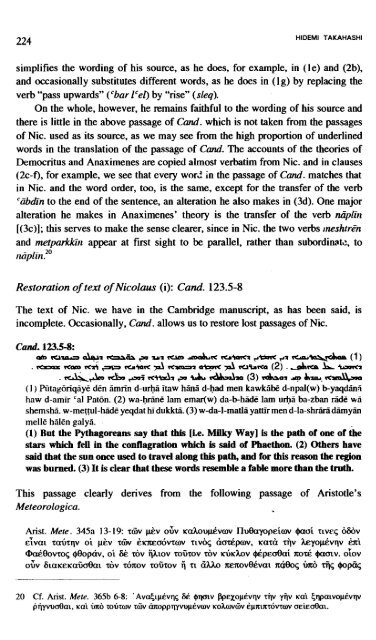doc.pdf
doc.pdf
doc.pdf
Create successful ePaper yourself
Turn your PDF publications into a flip-book with our unique Google optimized e-Paper software.
simplifies the wording of his source, as he does, for example, in (le) and (2b),<br />
and occasionally substitutes different words, as he does in (lg) by replacing the<br />
verb "pass upwards" ('bar l'el) by "rise" (sleq).<br />
On the whole, however, hs remains faithful to the wording of his source and<br />
there is little in the above passage of Cand. which is not taken from the passages<br />
of Nic. used as its source, as we may see from the high proportion of underlined<br />
words in the translation of the passage of Cand. The accounts of the theories of<br />
Democritus and Anaximenes are copied almost verbatim from Nic. and in clauses<br />
(2c-f), for example, we see that every wort in the passage of Cand. matches that<br />
in Nic. and the word order, too, is the same, except for the transfer of the verb<br />
'iibdn to the end of the sentence, an alteration he also makes in (3d). One major<br />
alteration he makes in Anaximenes' theory is the transfer of the verb niiplin<br />
[(3c)]; this serves to make the sense clearer, since in Nic. the two verbs mneshtr@n<br />
and metparkkin appear at first sight to be parallel, rather than subordinate, to<br />
ruiplin.20<br />
Restoration of text of Nicolaus (i): Cand. 123.5-8<br />
The text of Nic. we have in the Cambridge manuscript, as has been said, is<br />
incomplete. Occasionally,<br />
-<br />
Cand. allows us to restore lost passages of Nic.<br />
Cand. 123.5-8:<br />
am (U- +3 sib * u3 run, A e -49e3 +* +3 r ~pr\A (1)<br />
. r
















